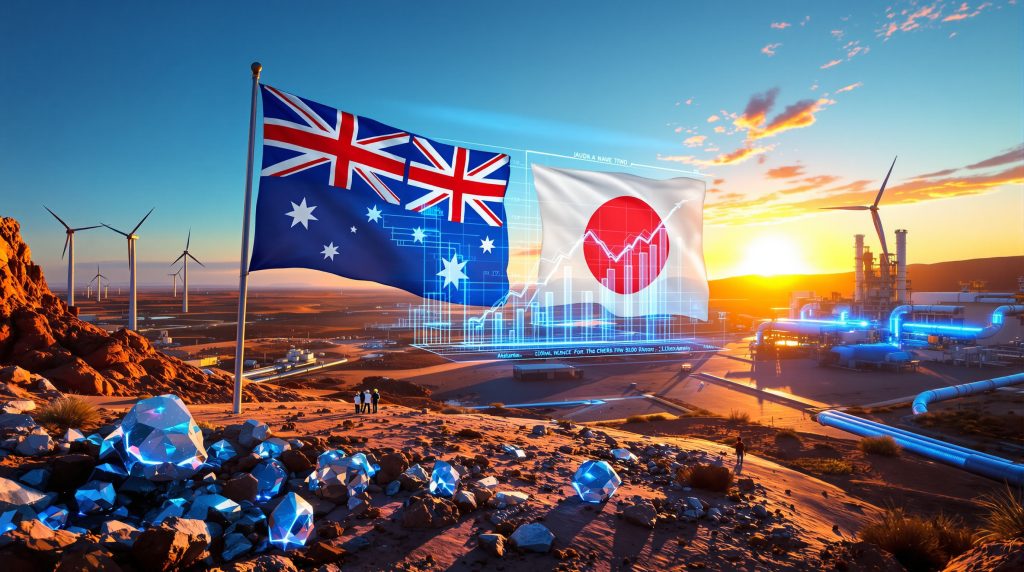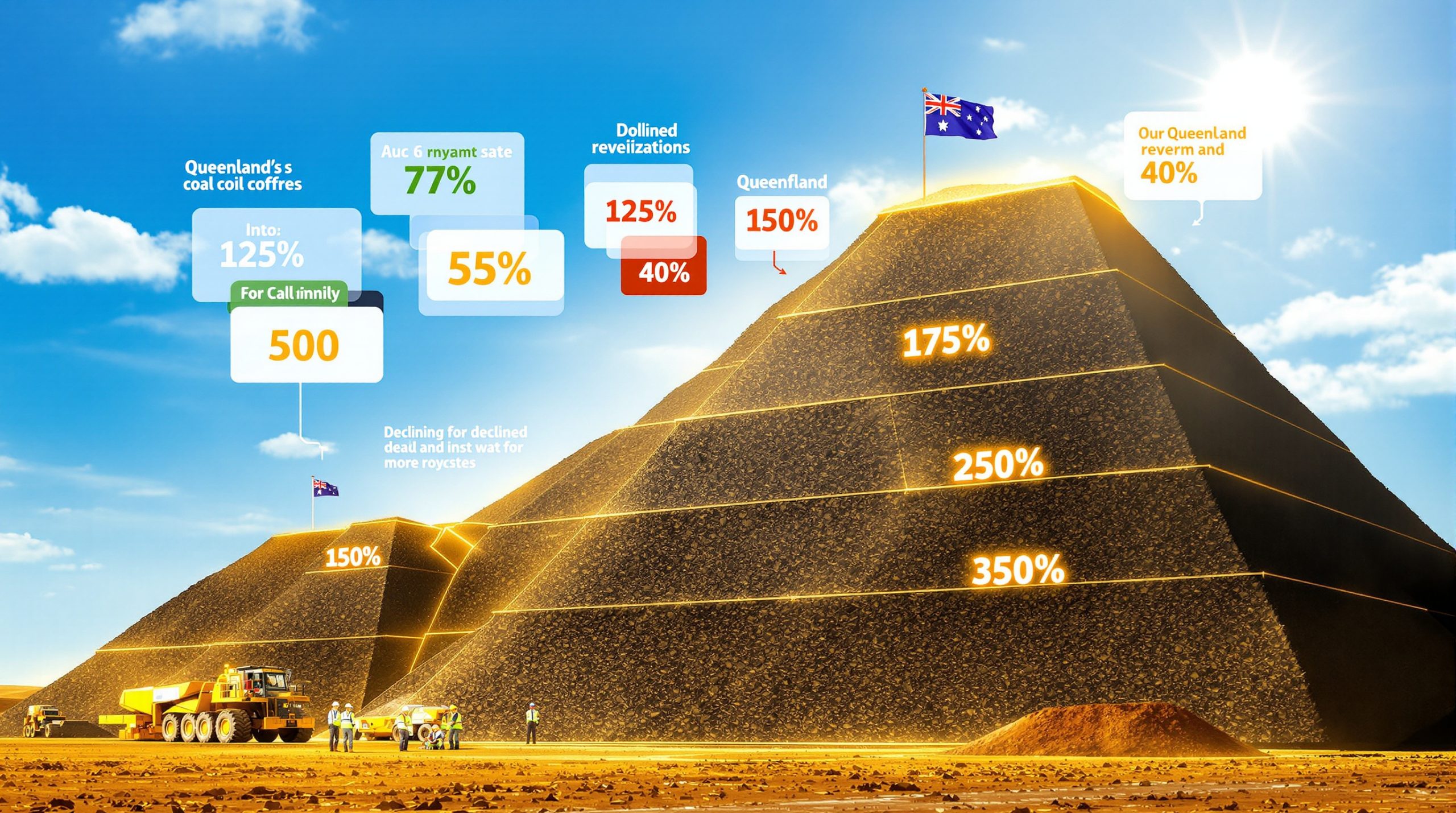Australia-Japan Critical Minerals Partnership: A Strategic Alliance for Energy Security
The Australia-Japan critical minerals relationship is evolving rapidly into a cornerstone of both nations' economic and energy security strategies. At the recent Osaka World Expo, Resources and Northern Australia Minister Madeleine King emphasized that energy security during the transition to net zero is a high priority for both nations, highlighting the strategic importance of this partnership. This relationship is moving beyond traditional resource trading toward a more integrated approach that encompasses mining industry evolution and clean energy technology development.
Both countries recognize that their economic futures depend on securing reliable supply chains for the materials that will power renewable energy systems and advanced manufacturing. What began as a simple trading relationship has transformed into a strategic alliance with implications for regional security and global critical minerals energy transition.
Strategic Objectives Driving the Australia-Japan Critical Minerals Exchange
The Australia-Japan critical minerals partnership serves multiple strategic objectives that align with both nations' long-term economic and security interests. These complementary goals have created a natural foundation for cooperation that extends beyond simple trade.
Supply Chain Resilience
Both Australia and Japan are working to develop alternative supply chains outside of existing dominant networks. For Japan, which imports nearly all its critical minerals, diversification represents a crucial economic security strategy. Australia, meanwhile, benefits from establishing more direct relationships with end-users of its mineral resources.
According to Minister King, "building more resilient and diverse critical minerals supply chains" remains a top priority for both nations. This focus has intensified following global supply chain disruptions experienced during recent years.
Energy Transition Support
The minerals at the center of this partnership form the backbone of renewable energy technologies. Lithium for batteries, rare earths for permanent magnets in wind turbines, and copper for electrical infrastructure are all essential components of the clean energy transition.
Both countries have committed to achieving carbon neutrality by 2050, making access to these materials a strategic necessity. Japan's manufacturing expertise in clean energy technologies pairs naturally with Australia's abundant mineral resources.
Economic Security Enhancement
For Japan, which has limited domestic mineral resources, securing stable supplies of critical minerals represents a fundamental economic security issue. For Australia, expanding beyond raw material exports to include more processing and manufacturing creates economic resilience against commodity price fluctuations.
Value-Added Processing Development
A key element of the partnership involves developing more processing capabilities within Australia. The Australian Government's Future Made in Australia agenda specifically supports domestic processing of battery metals investment and green metals, creating higher-value exports and more skilled jobs.
Net-Zero Commitment Support
Both Australia and Japan have committed to achieving carbon neutrality by 2050. Their critical minerals partnership directly supports these commitments by securing the materials needed for renewable energy systems and low-emission technologies.
Key Critical Minerals in the Australia-Japan Exchange
The partnership focuses on several key minerals essential for clean energy and high-tech applications. Each plays a specific role in the energy transition and offers unique opportunities for bilateral cooperation.
| Critical Mineral | Primary Applications | Australia's Role | Japan's Interest |
|---|---|---|---|
| Lithium | EV batteries, energy storage | Major global supplier with significant reserves in Western Australia | Securing supply for battery manufacturing and reducing dependence on Chinese processing |
| Rare earth elements | Permanent magnets for wind turbines, electric motors | Significant deposits in Northern Territory and Western Australia | Diversifying supply chains beyond China, which dominates global processing |
| Nickel | EV batteries, stainless steel | World's sixth-largest producer, with substantial reserves in Western Australia | Securing high-grade supply for advanced battery technologies |
| Copper | Electrical infrastructure, EVs, renewable energy systems | Substantial reserves in South Australia and Queensland | Essential for all electrification efforts and renewable energy transmission |
| Cobalt | Batteries, superalloys | Growing production as a byproduct of nickel mining | High-performance batteries for EVs and electronics |
| Graphite | Battery anodes, electronics | Developing resources in South Australia and Queensland | Securing supply for battery manufacturing to reduce dependence on Chinese processing |
Each of these minerals faces its own supply chain challenges, from concentration of processing capacity to environmental concerns associated with extraction. The Australia-Japan partnership aims to address these challenges through investment, technology sharing, and coordinated policy approaches.
Carbon Capture's Role in the Australia-Japan Minerals Partnership
Carbon capture and storage (CCS) has emerged as a significant component of the bilateral relationship. Japan views CCS as essential to meeting its 2050 net zero target and has been a major investor in Australian CCS developments.
During her visit to Japan, Minister King highlighted opportunities for transnational storage partnerships, noting the Asia-Pacific region's growing importance in global carbon storage. These CCS initiatives complement the critical minerals partnership by addressing emissions from mining and processing operations.
Australia's geological formations offer significant potential for carbon storage, while Japan brings technological expertise and investment capital. The partnership also explores carbon capture applications specific to critical mineral processing, which can be energy-intensive and carbon-intensive without proper mitigation measures.
Together, the two countries are working to develop cost-effective CCS solutions that can be applied across the critical minerals supply chain, potentially creating a competitive advantage through lower-carbon production methods.
Government Initiatives Supporting the Critical Minerals Exchange
Both Australian and Japanese governments have implemented policies and programs specifically designed to strengthen their critical minerals partnership.
Australian Government Initiatives
The Australian Government has launched several initiatives to support critical minerals development:
-
Future Made in Australia agenda – This comprehensive policy framework supports domestic processing of battery minerals and green metals, aiming to capture more value from Australia's mineral resources.
-
Northern Territory investment promotion – The NT government is actively positioning itself as a key partner in regional clean energy and critical minerals supply chains, with Minister Robyn Cahill leading a 20-person delegation to Japan.
-
Critical Minerals Strategy – Australia's national strategy prioritizes development of resources and processing capabilities for strategic minerals, with Japan identified as a key partner.
-
Critical raw materials facility – A government financing mechanism that helps Australian critical minerals projects secure capital for development and processing facilities.
Japanese Government Support
Japan has complemented Australian efforts with its own initiatives:
-
Significant investment in Australian mining and clean energy sectors through both private companies and government-backed entities
-
Promotion of joint ventures in critical minerals processing to secure supply chains
-
Technology transfer programs for advanced processing methods that can be implemented in Australia
-
Strategic resource agreements that provide certainty for both Australian producers and Japanese manufacturers
These coordinated policy approaches demonstrate the strategic importance both governments place on the critical minerals relationship.
Osaka World Expo: A Platform for Advancing the Minerals Partnership
The Osaka World Expo serves as a strategic platform for deepening economic and strategic ties between Australia and Japan. Australia's pavilion at the expo, which runs through October 13 and is expected to attract over 28 million visitors, showcases the nation's capabilities in resources, science, and advanced manufacturing under the theme "designing future society for our lives."
Within this framework, Australia is highlighting:
- Opportunities to expand local processing of battery minerals
- The strategic value of carbon capture and storage
- The importance of developing critical minerals strategic reserve
The expo provides a global stage for Australia to demonstrate its commitment to becoming more than just a supplier of raw materials. By showcasing its technological capabilities alongside its mineral resources, Australia is positioning itself as a partner in the entire supply chain from extraction to final application.
For Japan, hosting the expo offers an opportunity to highlight its leadership in advanced manufacturing and clean energy technologies, while emphasizing the importance of secure supply chains for the critical minerals these industries require.
Regional Engagement: Australian States and Territories in the Partnership
The Northern Territory is taking a proactive approach to engaging with Japan on critical minerals and clean energy. Trade, Business and Asian Relations Minister Robyn Cahill is leading a 20-person delegation to promote investment opportunities in mining, clean energy, and digital technologies.
This regional engagement complements federal efforts and demonstrates the multi-level nature of the Australia-Japan critical minerals relationship. The NT's approach illustrates how subnational governments are becoming increasingly important players in international economic partnerships, particularly in resource-intensive sectors.
Other states are also actively engaged:
-
Western Australia, home to significant lithium, nickel and rare earth deposits, has established trade offices in Japan and hosts regular investment delegations
-
South Australia is promoting its copper resources and renewable energy integration capabilities
-
Queensland is highlighting its critical mineral potential alongside renewable energy development opportunities
This multi-level engagement creates a more comprehensive partnership that addresses specific regional opportunities within the broader strategic framework.
Challenges Facing the Australia-Japan Critical Minerals Partnership
Despite the strong strategic alignment, several significant challenges must be addressed for the partnership to reach its full potential:
Processing Capacity Gaps
Australia still exports most raw minerals to China for processing, creating a vulnerability in the supply chain that the partnership aims to address. Developing domestic processing capacity requires significant investment, technical expertise, and time.
Investment Requirements
Establishing new processing facilities and upgrading existing mining operations to focus on critical minerals requires substantial capital investment. Coordinating public and private financing from both countries presents ongoing challenges.
Technical Expertise Development
Building specialized knowledge for advanced mineral processing remains a priority for Australia. While the country has significant mining expertise, the specialized processing technologies often remain concentrated in Japan and other advanced manufacturing nations.
Market Competition
Australia and Japan face strong competition in the critical minerals space. Other nations, including the United States, European Union members, and South Korea, are all seeking to secure their own critical mineral supply chains, creating a competitive global landscape.
Price Volatility Management
Critical mineral markets are subject to significant fluctuations, creating challenges for long-term investment planning. The partnership must develop mechanisms to manage this volatility while maintaining economic viability.
Regional Security Implications of the Partnership
The Australia-Japan critical minerals partnership extends beyond economic benefits to enhance regional security in several ways:
-
Diversifying supply chains away from potential geopolitical pressure points, reducing vulnerability to economic coercion
-
Strengthening alliance networks through economic integration that complements existing security relationships
-
Supporting shared values of open markets and rules-based trade against alternative models of state-controlled resource allocation
-
Building resilience against supply disruptions that could otherwise impact critical infrastructure and defense capabilities
-
Complementing broader security cooperation between two of the Indo-Pacific's leading democratic economies
By creating more secure supply chains for materials essential to both civilian infrastructure and defense technologies, the partnership contributes to broader regional stability and security.
Future Developments in the Australia-Japan Minerals Relationship
Looking ahead, several developments are likely to shape the evolution of the Australia-Japan critical minerals partnership:
Expanded Processing Investment
Japanese companies are expected to increase investment in Australian processing facilities, particularly for lithium, rare earths, and battery materials. These investments will help Australia move up the value chain while securing supply for Japanese manufacturers.
Technical Innovation
Joint research and development initiatives will focus on new extraction and processing technologies that improve efficiency and reduce environmental impacts. These collaborations will leverage Japanese technical expertise and Australian practical mining experience.
Broadened Mineral Focus
While current efforts concentrate on a handful of high-profile minerals, future cooperation will likely expand to include additional critical minerals such as vanadium, titanium, and manganese, which are important for specialized applications.
Clean Energy Integration
The partnership will increasingly integrate with broader clean energy initiatives, particularly hydrogen production and storage, where both countries have complementary strengths and shared interests.
Formalized Supply Arrangements
More structured supply chain agreements and guarantees will develop as the partnership matures, potentially including strategic stockpiling arrangements to buffer against market disruptions.
The Strategic Significance of the Australia-Japan Critical Minerals Exchange
The Australia-Japan critical minerals partnership represents more than a simple trading relationship—it embodies a strategic alignment of two advanced economies seeking to navigate the complex challenges of energy transition, supply chain security, and geopolitical competition.
By combining Australia's resource wealth with Japan's processing expertise and manufacturing capabilities, the partnership creates mutual benefits while contributing to global efforts to develop more sustainable and secure critical mineral supply chains. This collaboration offers a model for how resource partnerships can support broader strategic and sustainability goals.
As both nations work toward their net-zero commitments, the exchange of critical minerals and clean energy technologies will likely become even more central to their bilateral relationship, cementing a partnership that serves their economic, security, and environmental interests.
For investors and industry participants, the Australia-Japan critical minerals exchange represents not just current opportunities but a long-term strategic framework that will shape resource development, processing investments, and manufacturing capabilities across the Asia-Pacific region for decades to come.
Want to Stay Ahead of Critical Mineral Market Opportunities?
Gain instant insights into significant ASX mineral discoveries with Discovery Alert's proprietary Discovery IQ model, turning complex announcements into actionable investment opportunities. Explore how major discoveries can lead to exceptional market returns by visiting the dedicated discoveries page.




